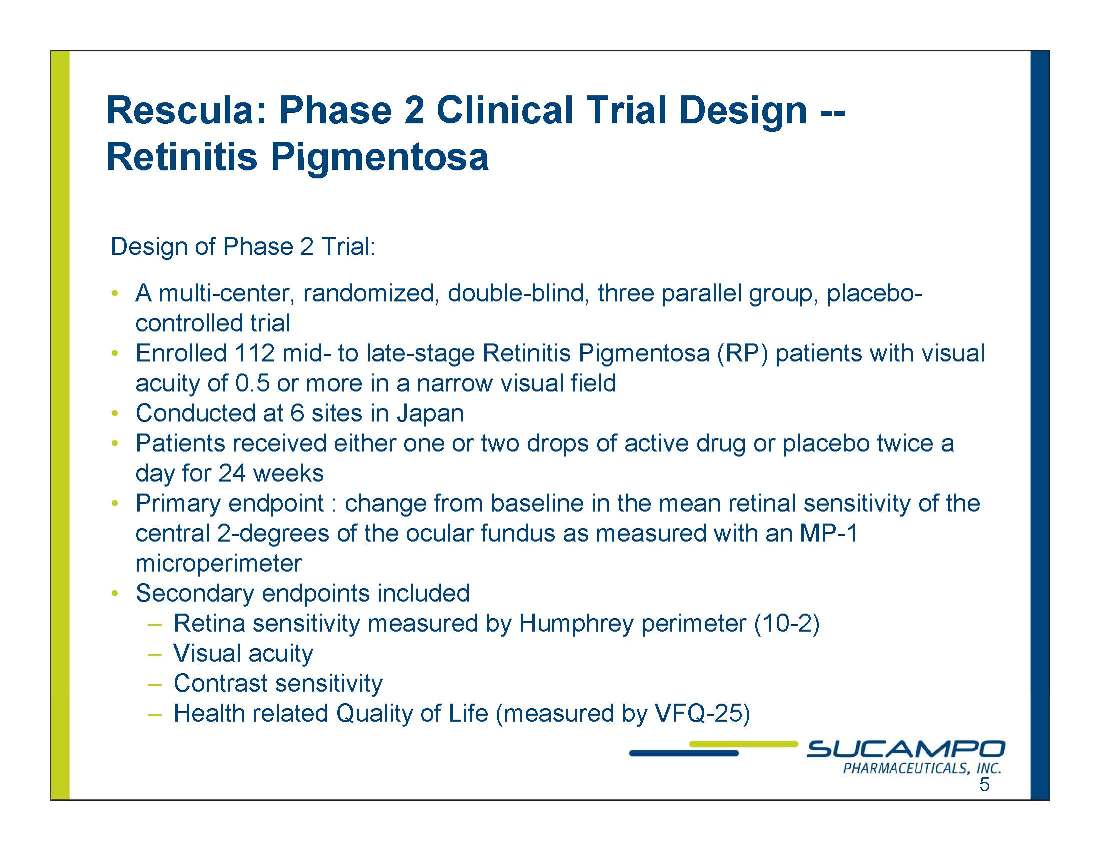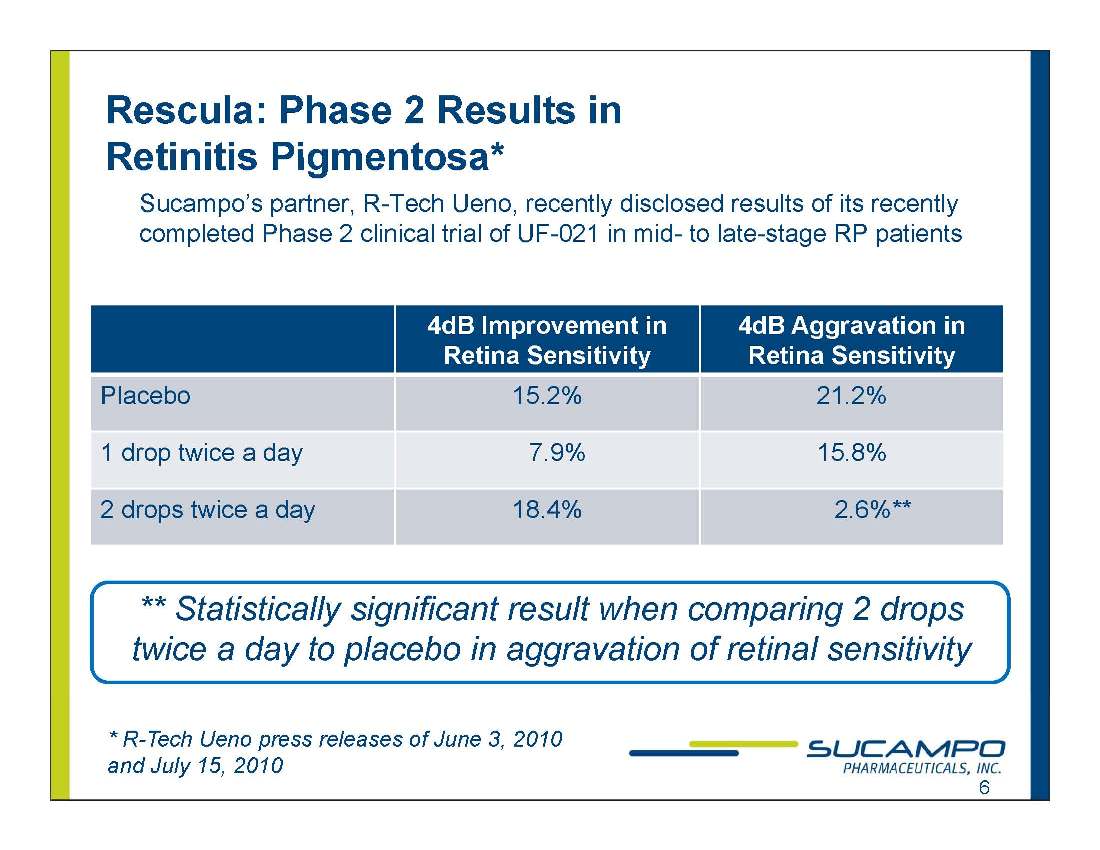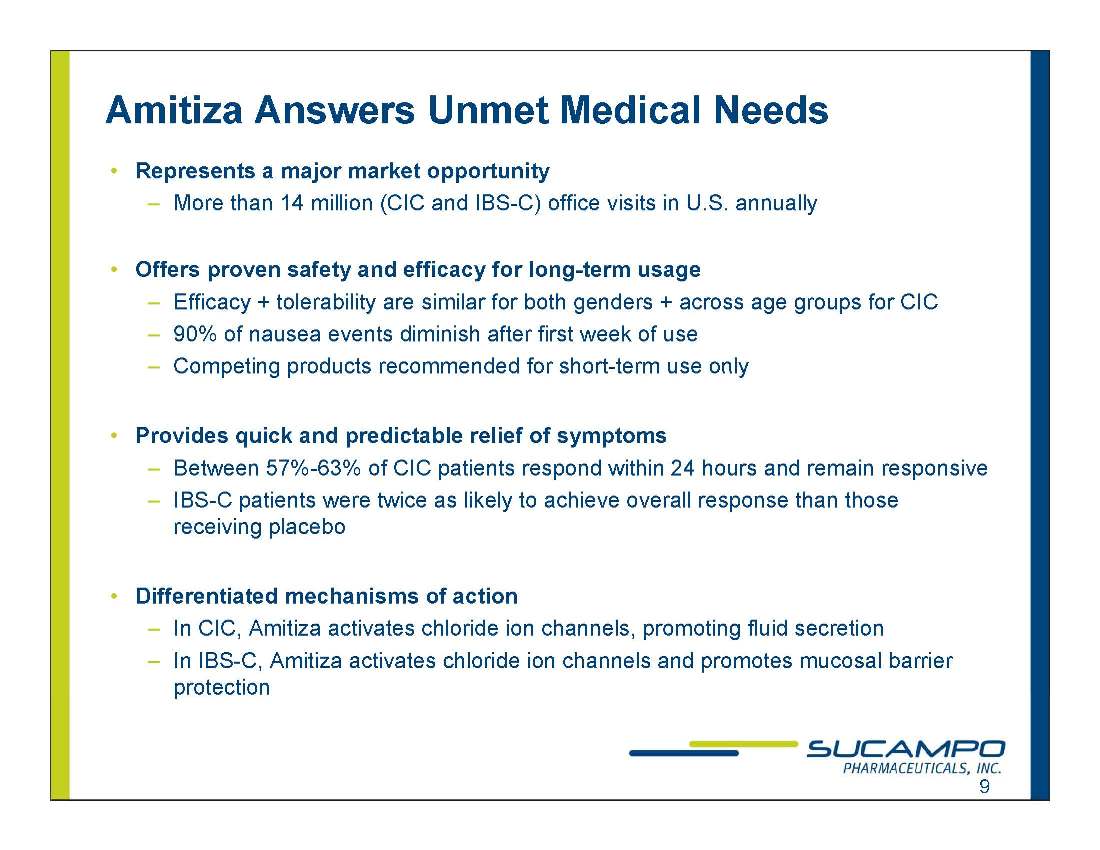Attached files
| file | filename |
|---|---|
| 8-K - SUCAMPO PHARMACEUTICALS, INC. 8-K - Sucampo Pharmaceuticals, Inc. | a6488892.htm |
Exhibit 99.1

2010 Mid-Atlantic BIO James J. Egan Chief Operating Officer October 29, 2010 1

Forward-Looking Statement Forward-looking statements contained in this presentation are based on Sucampo’s assumptions and expectations concerning future events. They are subject to significant business, economic and competitive risks and uncertainties that could cause actual results to differ materially from those reflected in the forward-looking statements. Sucampo’s forward-looking statements could be affected by numerous foreseeable and unforeseeable events and developments such as regulatory delays, the failure of clinical trials, the inability to fund drug development initiatives, competitive products and other factors identified in the “Factors” section of Sucampo’s 10-K and Risk Factors Sucampo s Annual Report on Form 10 other periodic reports filed with the Securities and Exchange Commission. While Sucampo may elect to update these statements at some point in the future Sucampo specifically disclaim any obligation to do so, whether as a result of new information, future events or otherwise. In light of the significant uncertainties inherent in the forward-looking information in this presentation, you are cautioned not to place undue reliance on these forward-looking statements. 2

Sucampo: A Biopharmaceutical Company Amitiza® – Only FDA approved drug for chronic idiopathic constipation (CIC) in adults – Only FDA approved drug for irritable bowel syndrome with constipation (IBS-C) in adult women – Marketing authorization approved ( Nov 2009) in Switzerland for CIC indication g pp ) – Phase 3 trial in opioid-induced bowel dysfunction (OBD) to initiate late 2010 – U.S + Canadian commercial rights held by Takeda, commercial rights in Japan held by Abbott Rescula – FDA approved intra-ocular pressure (IOP) in glaucoma for lowering intra and ocular hypertension in patients who are intolerant of or insufficiently responsive to other IOP lowering medications – In-licensed US + Canadian development and marketing rights in April 2009 – Awaiting FDA approval of label-enhancing supplemental NDA (sNDA) before re-launch in U.S. – additional indications partner’s breakthrough clinical Designing trials for indications, based on partner s results A deep pipeline leveraging prostone technology, expertise – Cobiprostone for prevention of NSAID-induced gastric ulcers in Phase 2 SPI-peripheral arterial – 017 for disease going into Phase 2 Additional prostones in preclinical development, such as SPI-3608 Strong financial position – $114 4 million investments (as of 30 114.4 in cash and June 30, 2010) 3

Rescula: In-Licensed from R-Tech Ueno Sucampo licensed US and Canadian rights to Rescula from R-Tech Ueno (RTU) in April 2009 Gained exclusive rights to commercialize Rescula in the U.S. and Canada for approved indications and right of first refusal to additional indications for which RTU develops Rescula Also received the right to develop Rescula for additional ophthalmic indications RTU to manufacture supply Rescula to Sucampo Sucampo paid $3 million upfront to RTU and is responsible for additional milestone payments Sucampo responsible for development, regulatory and commercialization activities and expenses in the U.S. and Canada 4

Rescula: Phase 2 Clinical Trial Design -- Retinitis Pigmentosa Design of Phase 2 Trial: A multi-center, randomized, double-blind, three parallel group, placebocontrolled trial Enrolled 112 mid- to late-stage Retinitis Pigmentosa (RP) patients with visual acuity of 0.5 or more in a narrow visual field Conducted at 6 sites in Japan Patients received either one or two drops of active drug or placebo twice a for 24 day weeks Primary endpoint : change from baseline in the mean retinal sensitivity of the central 2-degrees of the ocular fundus as measured with an MP-1 microperimeter Secondary endpoints included – Retina sensitivity measured by Humphrey perimeter (10-2) – Visual acuity – Contrast sensitivity – Health related Quality of Life (measured by VFQ-25) 5

Rescula: Phase 2 Results in Pigmentosa* Retinitis Pigmentosa Sucampo’s partner, R-Tech Ueno, recently disclosed results of its recently completed Phase 2 clinical trial of UF-021 in mid- to late-stage RP patients Placebo 15.2% 21.2% 1 drop twice a day 7.9% 15.8% 2 drops twice a day 18.4% 2.6%** ** Statistically significant result when comparing 2 drops twice a day to placebo in aggravation of retinal sensitivity * R-Tech Ueno press releases of June 3, 2010 and July 15, 2010 6

Rescula: A Differentiated Ophthalmic Drug A unique mechanism of action: Rescula activates Maxi K channels in neurons and contractile cells Lowers IOP by increased outflow of aqueous humor through trabecular meshwork and uveoscleral pathway Increases both retinal and choroidal components of ocular blood flow to optic nerve Maintains visual field in glaucoma patients; inhibits apoptosis of retinal neurons and ischemia-induced degeneration of optic nerve fibers in nonclinical clinical studies Leads to future opportunities in retinal diseases Prevention of Choroidal Neo-Vascular (CNV) formation in dry Age-related Macular Edema (AMD) Diabetic Macular Edema (DME) 7

Rescula: Current Status Rescula eye-drops are a prostone-based drug, not a prostaglandin FDA-approved for lowering of intra-ocular pressure (IOP) in primary openangle glaucoma (POAG) and ocular hypertension patients who are intolerant IOP of or are insufficiently responsive to other lowering medications; not currently available in U.S. Sucampo submitted data developed after Rescula’s FDA approval in 2000 in an sNDA (August 2009); Will complete label discussions with FDA before finalizing US launch plans * R-Tech Ueno press releases of June 3, 2010 and July 15, 2010 8

Amitiza Answers Unmet Medical Needs Represents a major market opportunity More than 14 million (CIC and IBS-C) office visits in U.S. annually Offers proven safety and efficacy for long-term usage – Efficacy + tolerability are similar for both genders + across age groups for CIC – 90% of nausea events diminish after first week of use – Competing short-only products recommended for short term use • Provides quick and predictable relief of symptoms – Between 57%-63% of CIC patients respond within 24 hours and remain responsive – IBS-C patients were twice as likely to achieve overall response than those receiving placebo • Differentiated mechanisms of action – In CIC, Amitiza activates chloride ion channels, promoting fluid secretion – In IBS-C, Amitiza activates chloride ion channels and promotes mucosal barrier protection 9

Amitiza: Chronic Idiopathic Constipation* Phase 3 pivotal trial design – 2 multicenter trials, both randomized, parallel-group, enrolled 479 patients – Administered 24 mcg gel capsule of Amitiza or placebo twice daily – 4 week treatment period preceded by 2 week baseline period – Entry criteria: modified Rome II criteria for functional constipation – Primary efficacy endpoint: change from baseline in number of spontaneous bowel movements (SBM’s) treatment SBM s) after 1 week of – Secondary endpoints included: SMBs at weeks 2, 3 and 4 Percentage of patients with a SBM within 24 hours of first dose Time to first SBM *Barish CF. Dig Dis Sci 2010; 55: 1090-1097 Johanson JF et al Am J Gastroenterol. 2008:103:170-177 10

Amitiza: Chronic Idiopathic Constipation* Phase 3 Trials Results Amitiza met the primary endpoint with statistical significance (p<0.0001), as Amitiza patients experienced statistically significantly greater mean numbers of SBMs at week 1 as compared to placebo patients (5.5 / 5.9 vs. 3.5 / 4.0) Secondary endpoint results: – In each week of the trials, Amitiza patients had significantly higher frequency of SBMs at all weeks except week 2 – Significantly higher percentage of Amitiza patients experienced a SBM within 24 hours of 57-61 3% vs 32-37%) first does as compared to placebo (57 61.3% vs. 32 – Time to first SBM was significantly shorter in Amitiza patients than with placebo Amitiza approved by FDA for CIC in January 2006 *Barish CF, et al Dig Dis Sci 2010; 55: 1090-1097 Johanson JF et al Am J Gastroenterol. 2008:103:170-177 11

Amitiza: Irritable Bowel Syndrome with Constipation* Constipation Design of two pivotal phase 3 trials – 2 multicenter trials identically designed, randomized, parallel-groups – 1,171 patients, all in U.S., received 8 mcg Amitiza gel capsule or placebo twice daily – 12 week treatment period after a 2 week baseline period – patients met Rome II Constipation-Predominant Entry criteria: all criteria for Constipation IBS – To measure relief, patients responded to a weekly question: “How would you rate your relief of IBS symptoms over the past week compared to how you felt before you entered the study?” 7-point scale used to rate relief: “ significantly relieved,” “ moderately relieved,” “ a little bit relieved,” “unchanged,” “a little bit worse,” “moderately worse,” “significantly worse” Endpoint • – Primary endpoint was percentage of overall responders in drug and placebo groups – An overall responder was a monthly responder for at least 2 of the 3 months of the study *Drossman DA, Chey WD, Johanson JF et al, Aliment Pharmacol Ther 2009 Feb;29(3):329-41 12

Amitiza: Phase 3 IBS-C Overall Responder Rate* Rate Study ‘431 13.8% 7.8% p=0.029 Study ‘432 12.1% 5.7% p=0.023 Pooled 13.0% 6.8% p=0.001 Amitiza approved by FDA for IBS-C in adult women in April 2008 *Drossman DA, Chey WD, Johanson JF et al, Aliment Pharmacol Ther 2009 Feb;29(3):329-41 13

Amitiza: Further Opportunities -- OBD Management of Opioid-induced Bowel Dysfunction in Non-malignant Pain Patients (OBD) 4.5 Million patients in U.S. suffer from OBD Conducted two phase 3 trials, one reached statistical significance for primary endpoint Sucampo to conduct another phase 3 trial to obtain approval, Takeda to share costs Design of Successful Phase 3 trial g Randomized, placebo-controlled, double-blinded, multi-center , 450 OBD patients per trial One 24-mcg gel capsule of lubiprostone or placebo twice each day 12 week treatment period Permitted concomitant pain medications included: fentanyl, methadone, morphine and oxycontin Primary endpoint: change from baseline in SBM frequency at week 8 without reduction in dose of study pain medication 14

Prostones Fuel Sucampo’s Growth and DeepProduct PipelineFatty Acids Prostones CIC (24 mcg) approved Re-launch in U S Reported phase 2 trial Planning phase 2 trial Several compounds January 2006 U.S. for prevention of NSAID-induced gastric ulcers for peripheral arterial disease selected for preclinical development IBS-C (8 mcg) approved April 2008 Phase 2 protocols for new indications under development 15

Prostones Work as Potassium, and Chloride Channel Activators Potassium channels activation Chloride channels activation Produce Promotes Hyperpolarization Cell Protection Fluid Secretion Tight junction Gastrointestinal OBD Cardiovascular Peripheral arterial disease (PAD) Myocardial infarction hypertension, CNS Stroke Alzheimer’s disease Parkinson’s disease Gastric ulcer Inflammatory bowel disease, etc. Arterial etc. Parkinson s Epilepsy Amyotrophic lateral Sclerosis (ALS) etc. Spinal stenosis Ophthalmology Oncology Pulmonary Glaucoma Macular Edema Dry AMD Retinitis Pigmentosa Chemoprotection Secondary prevention (adjuvant) Urology Chronic obstructive pulmonary disease (COPD) Asthma, etc. Overactive bladder Erectile dysfunction, etc. 16

Sucampo’s Clinical Product Opportunities Phase 3 Preclinical Phase 2 Phase 1 Filed Amitiza (lubiprostone) Discovery Opioid induced Bowel Dysfunction Non Malignant Pain Opioid-(OBD) in Non-Patients CIC in Japanese Patients CIC -- Swiss Marketing Authorization Application Approved Prevention of Choroidal Neo-Vascular Formation in dry AMD Rescula Cobiprostone Prevention of NSAID-Induced Ulcers Diabetic Macular Edema (DME) SPI-017 Peripheral Arterial Disease in Japanese Patients 17

Sucampo’s Financial Results and Position Product Royalty Revenue $27.5 $34.4 $38.3 $19.4 R&D Revenue* $59.4 $72.3 $24.0 $6.8 Total Revenue $91.9 $112.1 $67.4 $28.6 Net Income/(Loss) $13 2 $25 0 ($0 8) ($2 3) 13.2 25.0 0.8) 2.3) Earnings Per Share (diluted) $0.35 $0.59 ($0.02) ($0.05) Cash & $86 1 $121 5 $118 3 $114 4 Investments 86.1 121.5 118.3 114.4 *R&D Revenue includes reimbursement of clinical trial expenses, and revenue recognized from milestone payments for filing and approval of sNDA for IBS-C (in 2007 and 2008, respectively). 18

2010 Mid-Atlantic BIO James J. Egan Chief Operating Officer October 29, 2010 19
